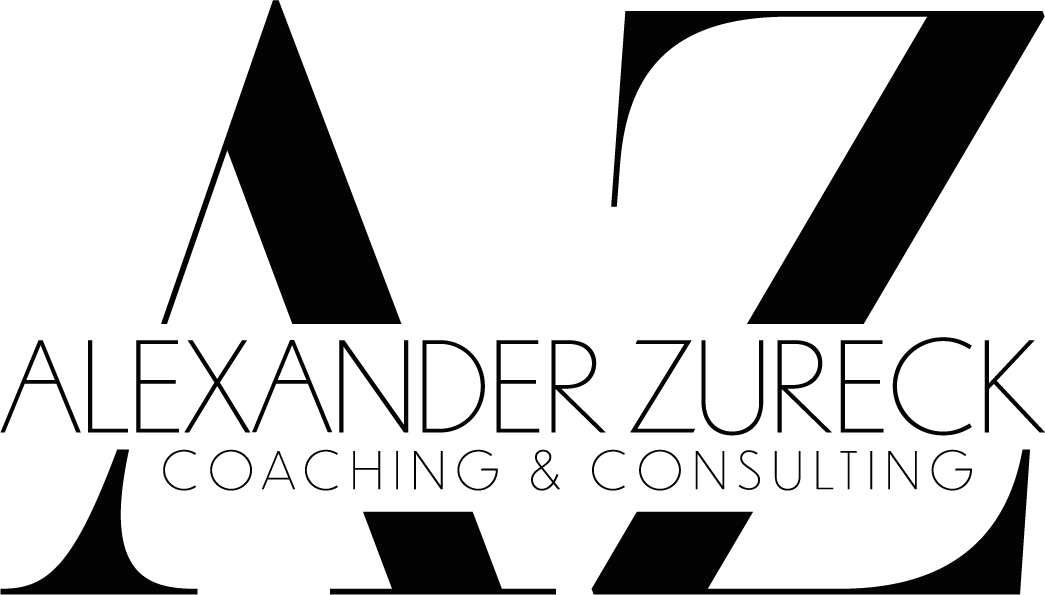Guidance for the Thesis

Finding a Topic and Initial Contact
How Do I Find a Topic for My Thesis?
I am always happy to be a supervisor for the thesis. Usually, my supervision starts with a brainstorming session on a possible topic, which we then develop together. I don’t need an exposé, because I think an agile approach makes more sense, as good new ideas keep coming up in our discussions, and sometimes a completely new topic emerges as a result.
You can find open topics in a concrete context related to my own research, teaching and other projects in the online campus.
Basically, however, I am open to many subject areas. We are always welcome to exchange ideas by telephone or via Zoom call (simply book an appointment). For supervision, I like to save the student’s photo and all contact details so that the supervision runs optimally and I have a picture in mind when we talk to each other. You can also find out more about my general supervision offer in this.
Specifying the Topic and Research Question of the Thesis
As a rule, I do not provide any fixed topic suggestions. Basically, I am open to many topics from different areas of general business administration. My own publications certainly serve as a guide here.
Registration of the Thesis
How, when and where Do I Have to Register My Thesis?
A registration/approval of the topic of the thesis in the online campus by me only takes place after the outline discussion has been completed.
Content-related Questions about the Thesis
Number of Hypotheses/Research Questions
Each thesis deals with an individual topic, which at the same time embodies the essential research question. In addition, it is advisable that no more than 3 core questions are investigated. What are the 3 core results of the thesis and what can theory and practice do with the results? Every author should be able to answer this question. Of course, further sub-questions can be answered on the main topic, but these sub-hypotheses are then no longer in focus. It is also important to work out the objective exactly, i.e. to formulate the goal as measurably as possible in order to be able to formulate a clear statement in the discussion and the conclusion.
Format of the Thesis
Scope of the Thesis
How many Pages should a Bachelor's/Master's Thesis Have?
The bachelor’s thesis has a scope of 40-60 text pages, i.e. figures, tables, etc. are not counted. Only the pure text counts. The master’s thesis has a scope of 60-80 text pages.
The 5 most Common Mistakes when Formatting a Thesis
How Do I Format and Structure My Thesis?
Uniformity is fundamentally important in scientific work in order to avoid typical errors, I will briefly address a few. I therefore recommend that students familiarize themselves with the formatting guidelines of the university or the degree program at an early stage and adhere to them carefully. Obtaining feedback from fellow students or supervisors can also be helpful in identifying and correcting possible formatting problems. A well-formatted thesis underlines the professionalism of your work and contributes to a positive overall assessment.
Tip: Format first, then start writing! How is that supposed to work? First, you develop a rough structure for your work: introduction, basics, research approach, summary, etc., which you can then further subdivide by thinking about what topics you need to follow in order to deliver an expressive work. In this way, you are already developing a common thread on the one hand and you only have to gradually fill your work with content. Here is an example:
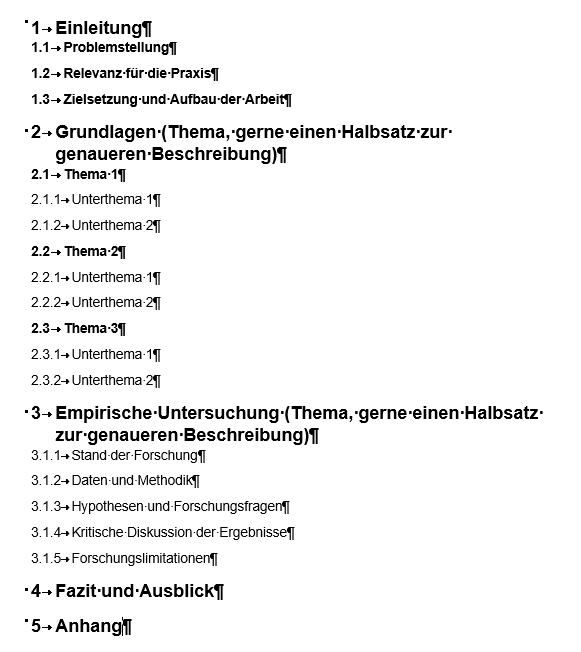
You can also assign a format to the headings and automatically get a better overview.

Even if you assign all page margins, line spacing, etc. beforehand, it will save you the tedious formatting of the entire work at the end. You should also avoid copying text from other sources into your work, as this can lead to formatting errors. Later they will make your life difficult because you will not recognize where the problem lies. It is also advisable to display paragraph marks and formatting symbols.
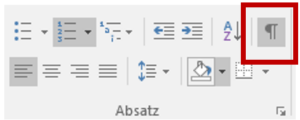
Failure to Comply with Citation Rules
How do you cite correctly? In scientific work, it is crucial to cite sources correctly in order to avoid plagiarism and maintain scientific integrity. Therefore, you should familiarize yourself with the citation rules, whether in APA (American Psychological Association), MLA (Modern Language Association) or another citation style, and apply them consistently.
1. APA citation style:
The APA style is often used in the social sciences and in business administration. In this style, references are made in the text that contain the author’s last name and the year of publication of the source. At the end of the document there is a complete bibliography with all sources used.
Example citation in the text:
“Market segmentation enables companies to address their target group more precisely and optimize their marketing strategies (Keller, 2018).”
Complete bibliography entry:
Keller, K. L. (2018). Strategic brand management: Building, measuring, and managing brand equity (5th ed.). Pearson.
2. MLA citation style:
The MLA style is mainly used in the humanities, including literary studies and history. Here, references are made in the text that contain the author’s last name and the page number of the cited source. At the end of the document there is a separate bibliography, which is referred to as “Works Cited”.
Example citation in the text:
“According to Smithers, the 19th century was a time of significant cultural change (25).”
Works Cited entry:
Smithers, James. Cultural Transformations of the 19th Century. Oxford University Press, 2015.
It is important for both citation styles that the exact details of the sources are listed in the bibliography. This includes the name of the author, the year of publication, the title of the work, the publisher and other information, depending on the type of source (e.g. page numbers for books, URL for online sources, etc.). The citation in the text must clearly refer to a specific source in the bibliography so that the reader can understand the exact origin of the information. To create a better overview in the bibliography, it should be sorted alphabetically (like all other directories). Consistency and accuracy are crucial to avoid plagiarism and to correctly present the source information in the work. I therefore always recommend using citation software to avoid errors. Mendeley, Citavi, Endnote etc. or a program that you are already familiar with and that complies with the citation rules (theses that are supervised by me) are suitable for this. It is only important that no careless mistakes are made, as is clearly more often the case with manual entry.
Internet sources please save as PDF file and submit accordingly.
Inconsistent Formatting
Consistent formatting is essential for a professional thesis. This includes the uniform design of headings, font sizes, line spacing, page margins and paragraph formatting. This also includes the fact that the line spacing of 1.5 should not only be observed for text modules, but of course also in connection with headings. Even if tables are integrated, please pay attention to uniform formatting (frame yes or no, text orientation within the table, etc.). Furthermore, 3D effects and shadows should generally be avoided. Inconsistent formatting can negatively affect the overall impression and distract from the quality of the work.
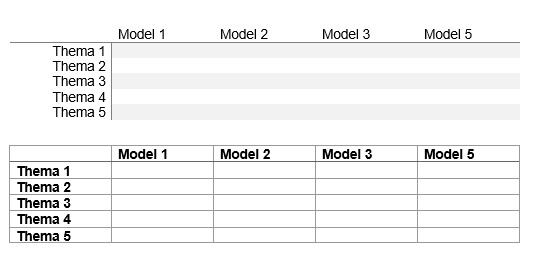
The style of the table is not relevant for the work, the main thing is: they are clear and all in the same formatting/style.
Unstructured Outline
A clear and meaningful outline is crucial to maintain the common thread of the work. You should divide your thesis into logical sections and sub-points to make the flow of reading easier and to present the content in an understandable way.
The introduction should be no more than one and a half pages. It is about getting to the point of the topic, briefly describing the problem, how current the whole thing is and what exactly the concrete investigation of your work is.
The length of a critical appraisal can of course vary depending on the context and objective. It is introduced as part of the discussion or conclusion and typically comprises about 10-20% of the total scope of the work. In terms of content, you should pay attention to the following:
- Summary of the results
- Evaluation of the research questions/hypotheses
- Classification of the results
- Strengths and weaknesses of the work
- Limitations and possible improvements
- Implications for practice
- Critical reflection
A well-structured critical appraisal enables you to consider your work in a broader context and make a contribution to the scientific discussion. The comparison between your own work and other studies is of immense importance and there should always be a connection to the literature. Make sure to formulate the argumentation clearly and precisely and to justify conclusions sufficiently.
Missing (Illegible) Table of Contents and Page Numbers
The table of contents provides an overview of the structure of the work, while page numbers make navigation easier. The absence of a table of contents or missing page numbers can cause confusion and make it difficult to find specific sections.
Furthermore, attention should also be paid to structure and formatting here: The chapter title in the example “2. Theoretical foundations” is too meaningless without reference to the work. Here you should make sure that the chapter title can be more extensive (half sentence). In addition, you should avoid designing your outline exclusively in bold, as this makes it difficult to read.
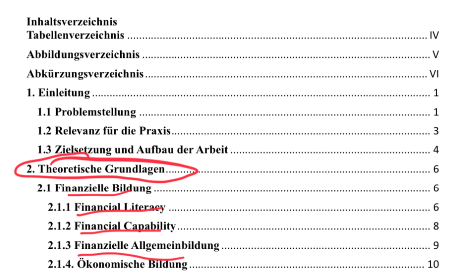
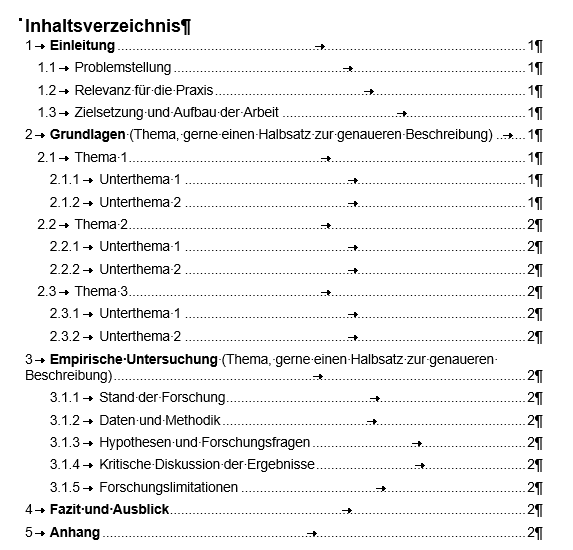
For the list of abbreviations, you should use tab stops for separation for a better overview and readability and not the equals sign “=” as in the example. It should also be noted that all directories can be found on a separate page and they are sorted alphabetically.
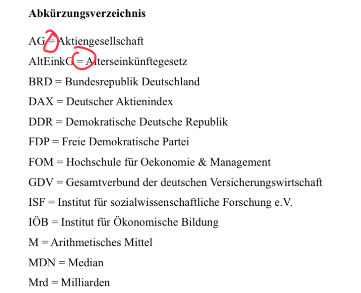
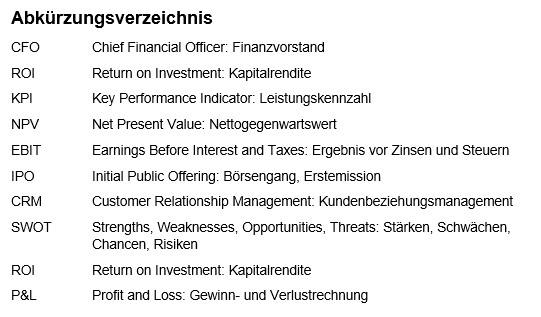
Neglect of Editing and Proofreading
Spelling mistakes, grammatical errors and stylistic deficiencies can significantly reduce the impression of an otherwise good work. A thorough editing and proofreading phase is essential to correct linguistic inconsistencies and submit a clean thesis.
The file should always be sent as a PDF and not as a Word file, as errors in formatting can occur depending on the version of the Office program or the end device (Mac <->Windows). You can also comment and make suggestions for improvement in a PDF.
Submission of the Thesis - Upload in the Online Campus
How and where Can I Submit or Upload My Thesis?
Two files can be uploaded in the online campus. First, the thesis must be uploaded as a PDF. In addition, a ZIP folder with further attachments, such as data sets or codings, can be uploaded.
Basically, your work should be uploaded in such a way that it can still be understood in 10 years what is and was important for the work. This means upload everything comprehensively and name all files comprehensibly, preferably in such a way that someone who has never seen the work before can understand which data sets, codings etc. can be found in which file.
If the upload does not work, you are welcome to submit a USB stick (in addition).
Colloquium
In the following video, I explain what is expected of you in terms of content in the colloquium. After submission, 6-8 weeks may pass until the colloquium. Further down are further details on possible topics that may come to mind when preparing.
Source: YouTube @alexanderzureck
Examination Format
The examination takes place virtually via Zoom. You can therefore carry it out from anywhere with a stable internet connection. Just in case, you should have your cell phone ready, because if the internet is unstable, you can dial into the exam by phone. Further information can also be found on the page “Online presentation in the colloquium: The right setup for an impressive appearance”.
Examination Language
The examination language is generally German, except in the MBA, where the examination is always in English. In principle, however, as a student, you can always say at the beginning of the examination that you would prefer to be examined in English. This is possible regardless of the degree program.
Examination Results
When and how Will I Find out My Examination Results?
If you are invited to the colloquium, you know that you have received at least a 4.0 in the written work from the second examiner and me. You will receive the exact grades as well as the grades for the colloquium at the end of the colloquium.
Theory-practice Transfer
A transfer assessment may take place before the actual colloquium on your thesis. Further information on this can be found in the examination regulations of the degree program. The transfer always takes place in the first 15 minutes of the colloquium, except for the MBA. Here, the examination performance is completely omitted.
Template for the Presentation
How Do I Design My PowerPoint Presentation for My Exam/Colloquium?
A special template is not to be used for the presentation. Figures must be provided with source information. Further source information does not have to be provided. Additional information on the design of the PowerPoint for the colloquium is also available in the article on the event “PowerPoint training for students”.
